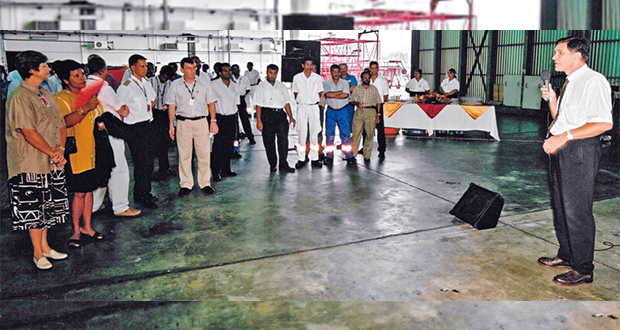Publicité
Time to understand our “blood pressure” and know our “numbers”
Par
Partager cet article
Time to understand our “blood pressure” and know our “numbers”

Educate the public and increase high blood pressure awareness. This is the aim of the World Hypertension day, celebrated on May 17, 2019. Normal blood pressure is vital to our good health; however, if abused, it can be deadly. In the words of famous cardio- thoracic surgeon Dr Mehmet Oz, “If you don’t know your blood pressure, it’s like not knowing the value of your company.” The circulatory system was eloquently described by the prominent English physician William Harvey in his famous work “de Motu Cordis” as early as 1628. The correct blood pressure measurement method was shown to us by the Russian Physician Dr Nikolai Korotkoff in 1905. Yet, blood pressure continues to baffle many of us even now.
A glimpse at the basic facts about arterial blood pressure (B. P.)
1. The arterial B. P. is the pressure exerted by flowing blood on the walls of the arteries.
2. There is a pressure gradient in our circulatory system.
3. The pressure in heart and arteries during contraction (systole) is greater than pressure in heart and arteries during relaxation (diastole).
4. B. P. gradient is fundamental to circulation of blood in the body because blood, like all fluids, moves from high pressure to low pressure. If there is no pressure gradient, circulation will stop.
5. Until mentioned otherwise, B. P. commonly refers to arterial B. P.
6. The normal B. P. in adults is below 120/80 mm Hg at rest, upper figure is systolic B. P. & lower is diastolic B. P.
7. B.P. fluctuates throughout the day depending on mental & physical activity.
8. Physical exercise increases systolic B. P & lowers diastolic B. P.
When & why does B. P. rise?
1. B. P. begins to show increasing trend soon after birth.
2. Below is the graphical representation of normal changes in B. P. with age:
3. The normal cut-off value of less than 120/80 mm Hg for all adults older than 18 years has been derived from numerous studies which prove that B. P. higher than this leads to complications like stroke, heart attack, kidney failure, dementia and death.
4. The risk of these complications keeps on doubling for every 20/10 mm Hg increase of B. P. from 120/80mm Hg onwards.
5. On an average, by the age of 40 years, 1/3rd of the population experiences B. P. over 140/90 mm Hg. By the age 60 years, about 2/3 of the population has blood pressures above 140/90 mm Hg. 6. B. P. rises due to genetic and environmental factors.
7. The environmental factors like smoking, alcohol abuse, sedentary lifestyle, excess salt intake, lack of fruit & vegetable consumption etc. contribute greatly in B. P. elevation.
8. Many medical conditions like diabetes, obesity, kidney diseases, depression, mental stress, sleep disorders are strongly associated with high B. P.

How to detect & manage high B. P.?
1. The best way for timely detection of high B. P. is regular measurement of B.P. after attaining adulthood. It is a “silent killer” which usually does not cause any symptoms.
2. If your B. P. is below 120/80 mm Hg , measure once in 2 years; if 120-139/80- 89 mm Hg, measure every year; if 140/90 or greater, contact your doctor.
3. The World Health Organization (WHO) recommends automated B. P. measurement device by OMRON company for B.P. measurement.
4. The size of cuff is important. If you are big sized individual, contact your doctor for choosing your cuff size.
5. Prevention and management of high BP requires following lifestyle changes:
• Stop smoking, no drugs.
• Reduce alcohol, caffeine intake.
• Exercise-moderate intensity (30 minutes, at least five times a week).
• Increase fruit and vegetable consumption (at least 4-5 servings per day).
• Reduce salt intake (less than a teaspoon/ 5 grams per day).
• Maintain healthy body weight.
• Sleep well for 6-8 hrs a day.
6. In addition to lifestyle changes, B. P. 140/90mm Hg or greater requires optimum medication and regular medical follow-up by a qualified doctor.
7. In optimum doses, these medications are very safe, efficacious and non-addicting.. It is very important to take prescribed medication regularly to maintain B. P. in the normal range.
How can we win the war against this “silent killer” ?
By getting rid of ignorance & increasing awareness about high B. P. in our communities.
MAY MEASUREMENT MONTH is an initiative of the International Society of Hypertension wherein free B. P. measurement and counselling is offered to all during the month of May and 17 May is celebrated as the International Hypertension Day. Join us in this noble endeavour by “knowing your numbers”. Feel free to request us for free BP measurement and counselling at City Clinic, Port Louis during the month of May.
By Dr. Maneesha BHAYA, M.D., DNB (Cardiology), FESC Senior consultant cardiologist, City Clinic Group
Publicité
Les plus récents






